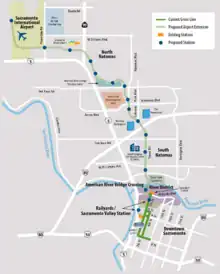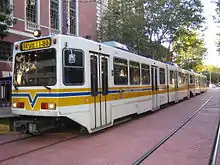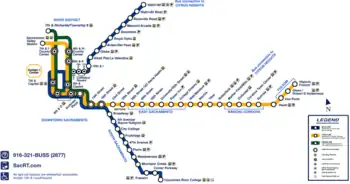Sacramento RT Light Rail
Sacramento RT Light Rail is a 42.9-mile (69.0 km) light rail system that serves the Sacramento, California area. It consists of three rail lines, 54 stations, and a fleet of 96 vehicles. It is operated by the Sacramento Regional Transit District (RT). With an average of 21,000 weekday daily boardings as of the second quarter of 2023, the RT light rail system is the sixteenth busiest in the United States.
History

The Sacramento Regional Transit District (also known as simply RT) began planning for a light rail system in the mid-1980s, after the successful opening of the San Diego Trolley in 1981 and amid a surge in light rail construction in mid-sized cities nationwide (Buffalo, Denver, Portland, and San Jose also built systems at the same time).[5]
The first line of the light rail system opened on March 12, 1987. Originally branded as RT Metro,[6][7] the new line linked the northeastern and eastern corridors which both parallel Interstate 80 and Route 50 respectively with Downtown Sacramento.[8] More specifically, the "starter line" ran between Watt/I-80 and Butterfield stations.[9] The line from Butterfield to the Western Pacific line ran on the former Sacramento Valley Railroad. The right of way between Q and R Streets running from 10th to 17th Streets was a former Western Pacific Railroad branch.[10] The line between downtown and Arden Way employed city streets, then turned on a former Western Pacific spur.[11] At the Southern Pacific right of way, the line turned to parallel it for a few miles before transitioning into the median of Interstate 80.
As light rail ridership increased, RT continued to expand the light rail system. In 1993, two infill stations were added on the existing RT Metro line: 39th Street and 48th Street. In September 1998, the line was extended from Butterfield station to Mather Field/Mills station. In September 2003, Sacramento Regional Transit opened the first phase of the South Line (now called the Blue Line), which was a 6.3-mile (10.1 km) extension to South Sacramento. In June 2004, light rail was extended from the Mather Field/Mills station to Sunrise Boulevard, and on October 15, 2005, a 7.4-mile (11.9 km) extension from the Sunrise station to the city of Folsom was opened.
Sometime in the late 1990s, the RT Metro branding quietly fell into disuse. It is now simply known as the RT light rail system.
In December 2006, the final leg of the Amtrak/Folsom project was extended by 0.7-mile (1.1 km), to the downtown Sacramento Valley Station, connecting light rail with Amtrak inter-city and Capitol Corridor services as well as local and commuter buses. In 2012, RT completed the first phase of the Green Line. The second phase of the line is planned to reach to the Sacramento International Airport.[12] In August 2015, RT extended service south to Cosumnes River College.[13]
Sacramento RT Light Rail ridership peaked at 16.8 million rides in 2008, but has declined to 9.7 million rides in 2018, a drop of 42% during that period.[14]
System
Lines
- Blue Line: North Sacramento–Downtown–South Sacramento
- Gold Line: Downtown–East Sacramento–Rancho Cordova–Folsom
- Green Line: Downtown–River District
Headways
All routes operate every 15 minutes on weekdays and every 30 minutes at night and on the weekend.[15]
Stations
.JPG.webp)
The stations along the network are open-air structures featuring passenger canopies for protection from adverse weather. Twenty-six stations offer bus transfer services and 22 have park-and-ride lots with a total of 10,113 available parking spaces.[1]
The busiest stations in the system by average daily boardings/alightings are: 16th Street (6,800), University/65th (3,000), Cosumnes River College (2,900), and 29th Street (2,900).[15]
Works of public art included at several stations were developed as part of the RT Public Art Program, and represent an array of media including, mosaics, sculptures, metalwork and murals. Each was commissioned to incorporate an identity and sense of place unique to the neighborhood surrounding the station.[16]
Rolling stock
The LRV fleet is composed of cars from two different builders: 36 from Siemens-Duewag U2A, some of which have been in use since the RT opened and 40 newer ones delivered in 2003 from Construcciones y Auxiliar de Ferrocarriles USA (CAF USA).
The fleet will be further augmented by at least 44 brand new Siemens S700 series low floor light rail vehicles starting in 2022 with plans to eventually acquire 76 units to replace the existing aging fleet as additional funding is secured.[17][18] 8 more trainsets were ordered in October 2023.[19]
| Numbers | Qty | Built | Manufacturer | Model | Notes |
|---|---|---|---|---|---|
| 35 | 1 | 1912 | American Car Company | California car | Restored historic electric streetcar, used for special events |
| 101–126 | 26 | 1985–1986 | Siemens–Duewag | U2A | To be withdrawn from operation starting by the summer of 2024 |
| 127–136 | 10 | 1990–1991 | Siemens | U2A | To be withdrawn from operation starting by the summer of 2024 |
| 201–240 | 40 | 2002–2003 | CAF USA | S/200 | |
| 401-444 | 44 | 2022–2024 | Siemens | S700 | Delivery to be completed by the end of 2024 and start to enter into service by summer 2024.[20][21] |
Former rolling stock
RT previously operated 20 Urban Transportation Development Corporation (UTDC) ALRV cars. These LRVs were built between 1985 and 1987 for the Santa Clara Valley Transportation Authority (VTA). After being withdrawn from use by VTA, they were purchased by RT and refurbished by Siemens in 2015.[4][22] In RT service, they carried fleet numbers 301 through 320. They were withdrawn from use in 2022.
Future projects
Level boarding
With the acquisition of low-floor Siemens vehicles, the system's station platforms are planned to be raised to eight inches (20 cm) above the top of the rail to allow a small bridge plate to be used to load passengers who require it.
The system's five stations constructed after 2006 were designed for low-floor vehicles and will not require modification. The Gold Line stations will be the first to have their platforms raised, followed by the Blue Line stations. SacRT plans to raise platforms in two phases, with half (two car lengths) of a platform (generally four car lengths) taken out of service during construction.[23]
Green Line to Sacramento International Airport

The Green Line extension to Sacramento International Airport will extend service 12 miles (19.3 km) to the airport via the Natomas neighborhood.[12][24] The line would extend northwest from the existing Green Line terminus at the 7th & Richards / Township 9 station. The plan to extend light rail to the airport has been in the works since early 1990s and is the project most requested by residents of the Sacramento region.[25] The agency has completed preparing the draft environmental impact report for the project.[26]
The project, estimated at nearly $1 billion, would be the costliest in RT's history and securing funding has been a challenge.[25] Transportation officials most recently proposed funding the project with a half-cent sales tax increase in Sacramento County, but the measure was narrowly defeated in November 2016.
References
- "RT Fact Sheet" (PDF). Sacramento Regional Transit District. June 2015. Retrieved September 9, 2015.
- "Transit Ridership Report Second Quarter 2023" (PDF). American Public Transportation Association. September 13, 2023. Retrieved September 21, 2023.
- "Transit Ridership Report Fourth Quarter 2022" (PDF). American Public Transportation Association. March 1, 2023. Retrieved March 29, 2023.
- "Sacramento Regional Transit Light Rail Fact Sheet" (PDF). Sacramento Regional Transit. February 2008. Retrieved January 23, 2007.
- Minister, R. David; Clarke, David J. (March 30, 1982). "Factors to Consider in Designing a Joint Bus-Light Rail Transit Mall" (PDF). Transportation Research Board.
- "Connections: Sacramento Light Rail & Bus Schedules". The Sacramento Bee. March 22, 1987. p. 2.
- "RT Metro Light Rail Timetable". Sacramento Regional Transit District. March 16, 1987.
- "SacRT History". www.sacrt.com. Retrieved May 2, 2019.
- "Light Rail map". Sacramento Regional Transit District. October 13, 1999. Archived from the original on October 13, 1999. Retrieved May 2, 2019.
- Depster, Doug (October 19, 1983). "Light-Rail Delays Could Raise Costs". Sacramento Bee. p. 19. Retrieved October 24, 2023 – via Newspapers.com.

- Dempster, Doug (December 28, 1982). "New Light-Rail Controversy". The Sacramento Bee. p. 12. Retrieved October 24, 2023 – via Newspapers.com.
- "Home". Green Line 2 Airport. Retrieved May 2, 2019.
- "RT Celebrates Grand Opening of Blue Line to Cosumnes River College Light Rail Extension". Sacramento Regional Transit District (Press release). August 22, 2015. Retrieved December 4, 2018.
- "Sacramento Regional Transit District (Sacramento RT)". National Transit Database. Retrieved March 14, 2019.
- "SacRT System Fact Sheet" (PDF). Sacramento Regional Transit District. July 2021. Retrieved February 14, 2022.
- "Art on Track – Station Art Along Light Rail" (PDF). Sacramento Regional Transit District. Archived from the original (PDF) on January 3, 2010. Retrieved February 2, 2010.
- "SacRT Purchases New Low-Floor Light Rail Vehicles" (Press release). Sacramento Regional Transit. April 22, 2020. Retrieved April 24, 2020.
- Arrington, Debbie (July 6, 2020). "SacRT trains to get low-profile upgrade: Sacramento-built light rail vehicles part of system-wide modernization". Chico News & Review Spotlight. Retrieved August 22, 2020.
- "Sacramento Regional Transit adds to order for Siemens light rail equipment". Trains.com. October 10, 2023. Retrieved October 10, 2023.
- "SacRT Awarded $45 Million by FTA for New Light Rail Vehicles – Sacramento Regional Transit District".
- "Light Rail Modernization Project – Sacramento Regional Transit District".
- "Siemens-refurbished light rail vehicles to begin operating on new Sacramento Regional Transit line". Siemens USA (Press release). September 8, 2015. Archived from the original on November 4, 2016. Retrieved November 3, 2016.
- "Light Rail Modernization Project". Sacramento Regional Transit District. Retrieved July 16, 2022.
- "Sacramento RT website: "Green Line to the Airport"". Archived from the original on May 27, 2012.
- Bizjak, Tony (January 7, 2015). "When will Sacramento get light rail to the airport? Not soon". The Sacramento Bee. ISSN 0890-5738. Retrieved July 10, 2018.
- "SacRT Initiatives". October 15, 2019. Retrieved April 15, 2021.


